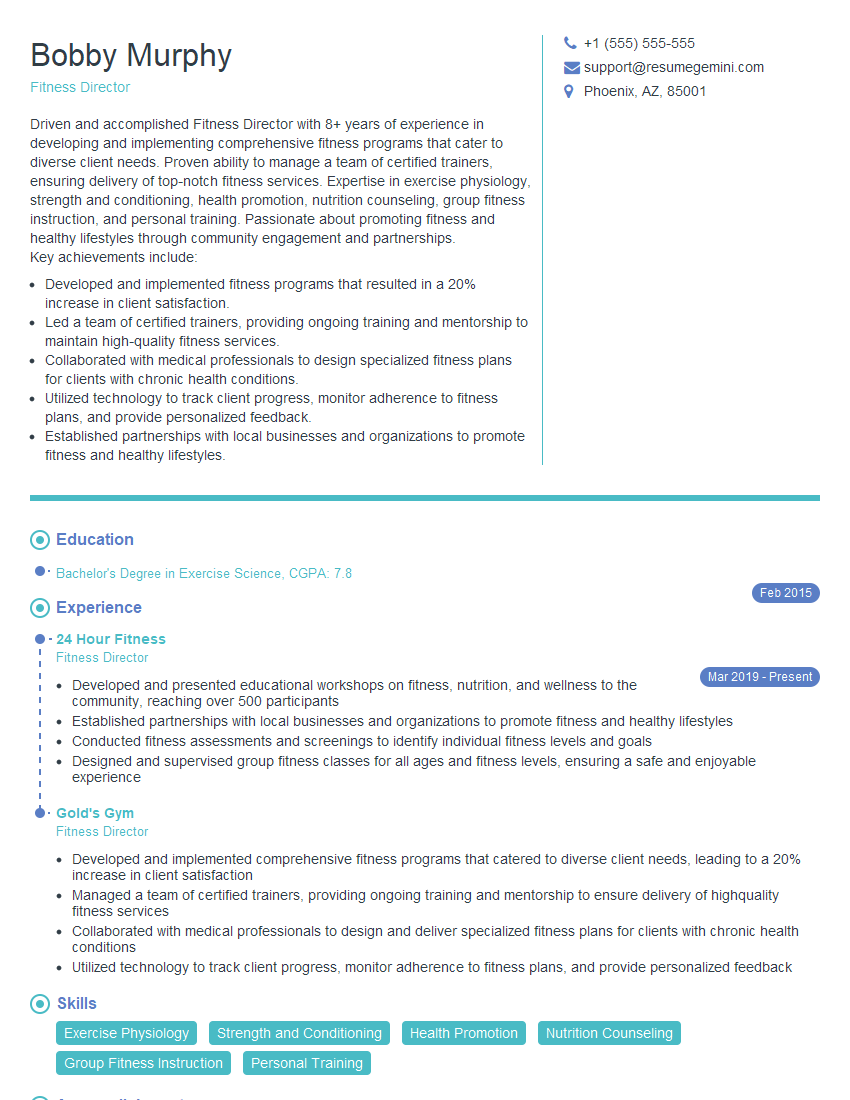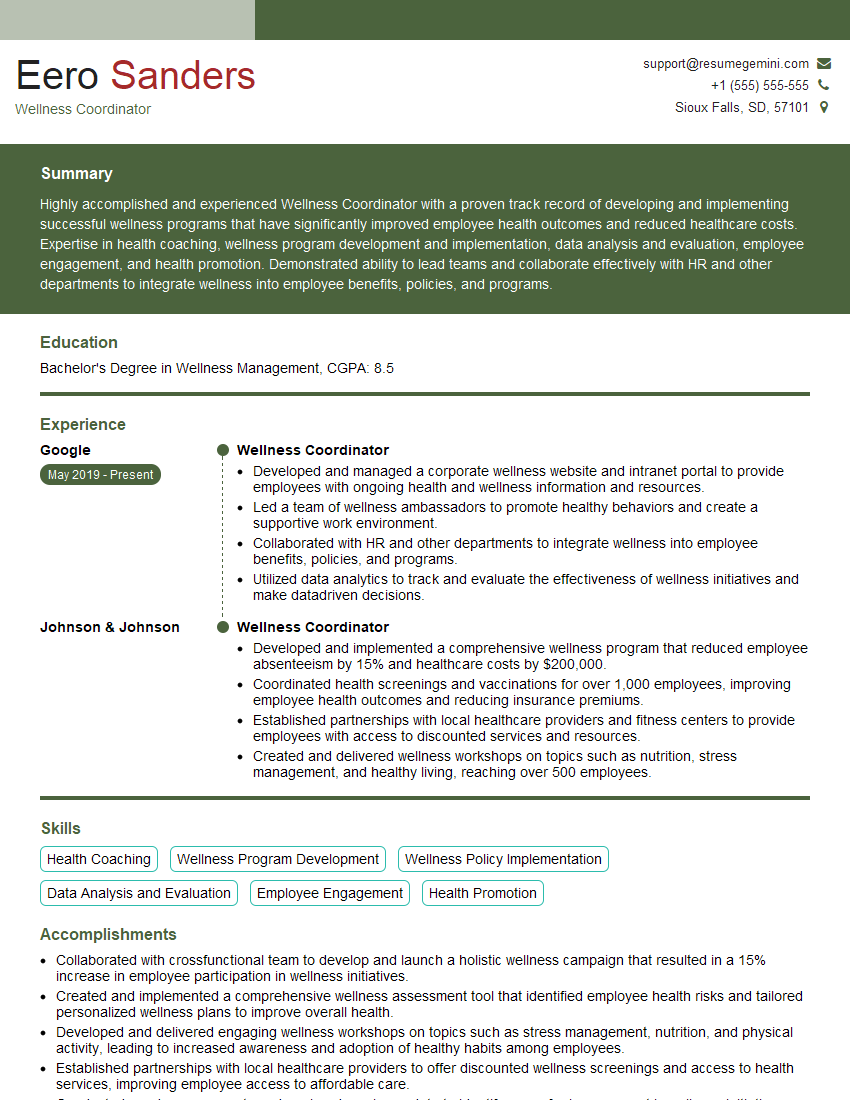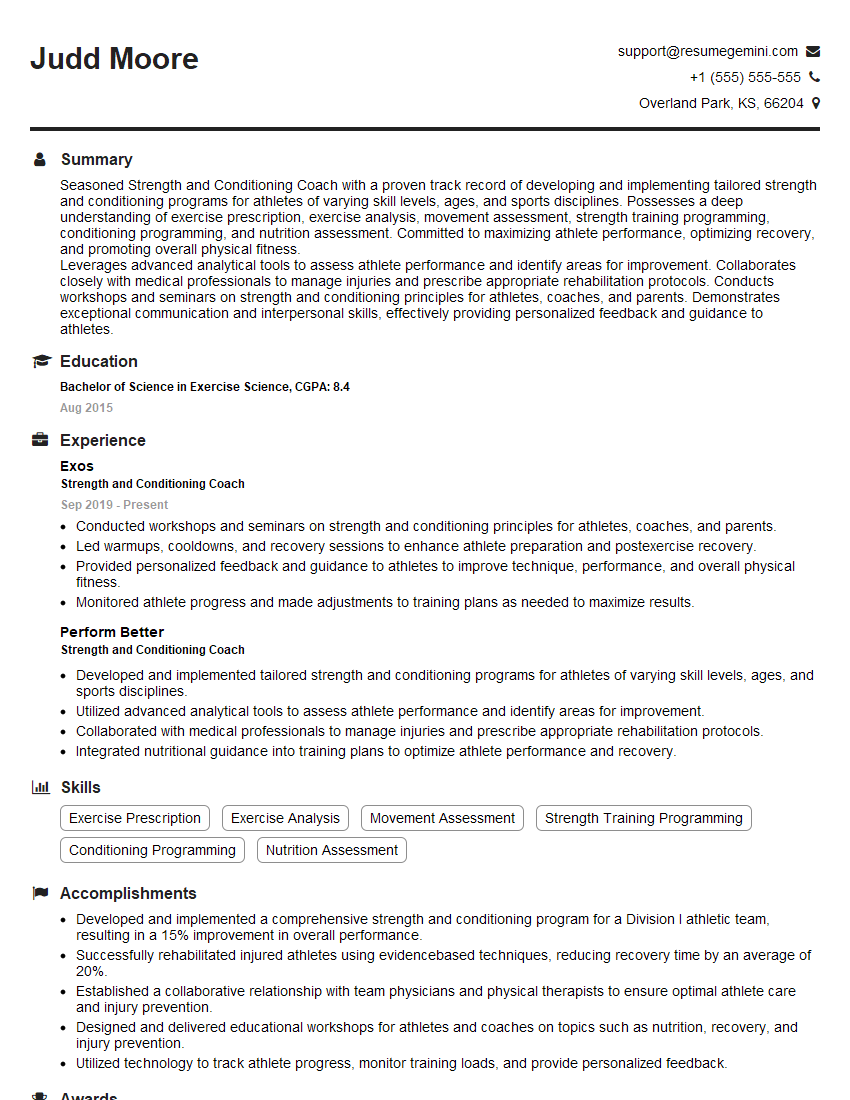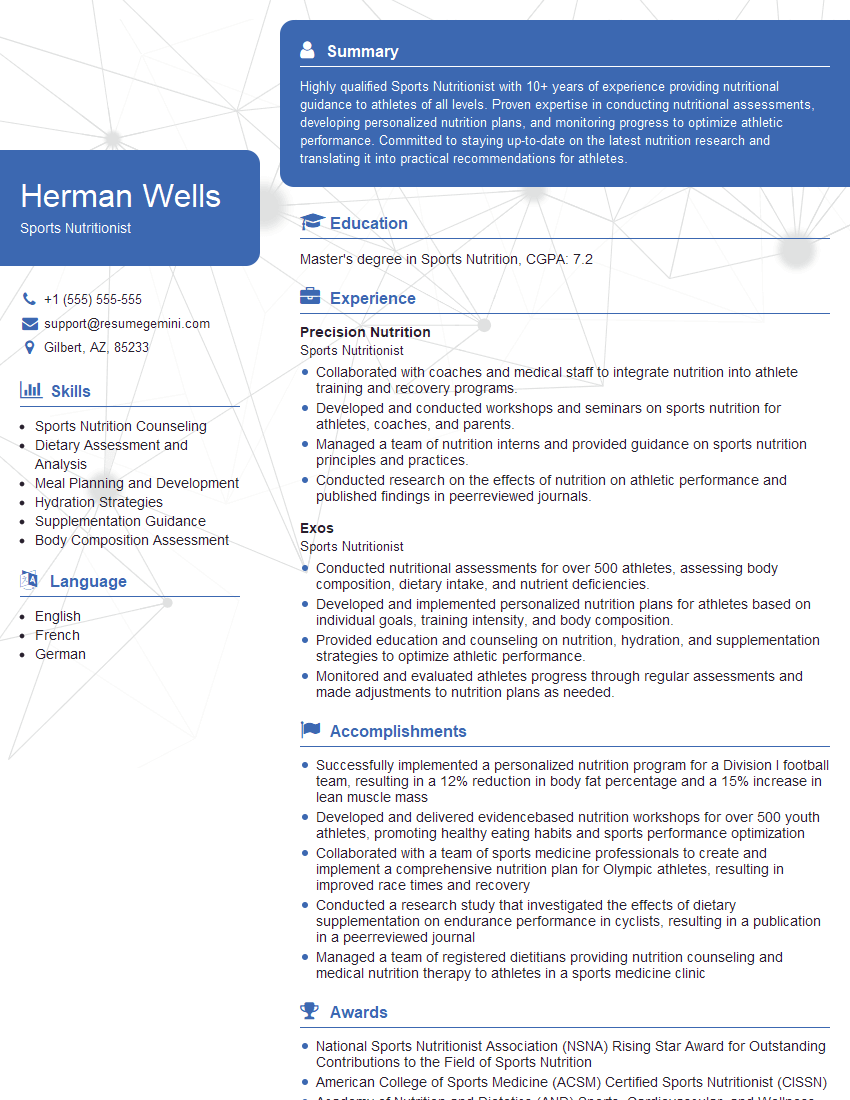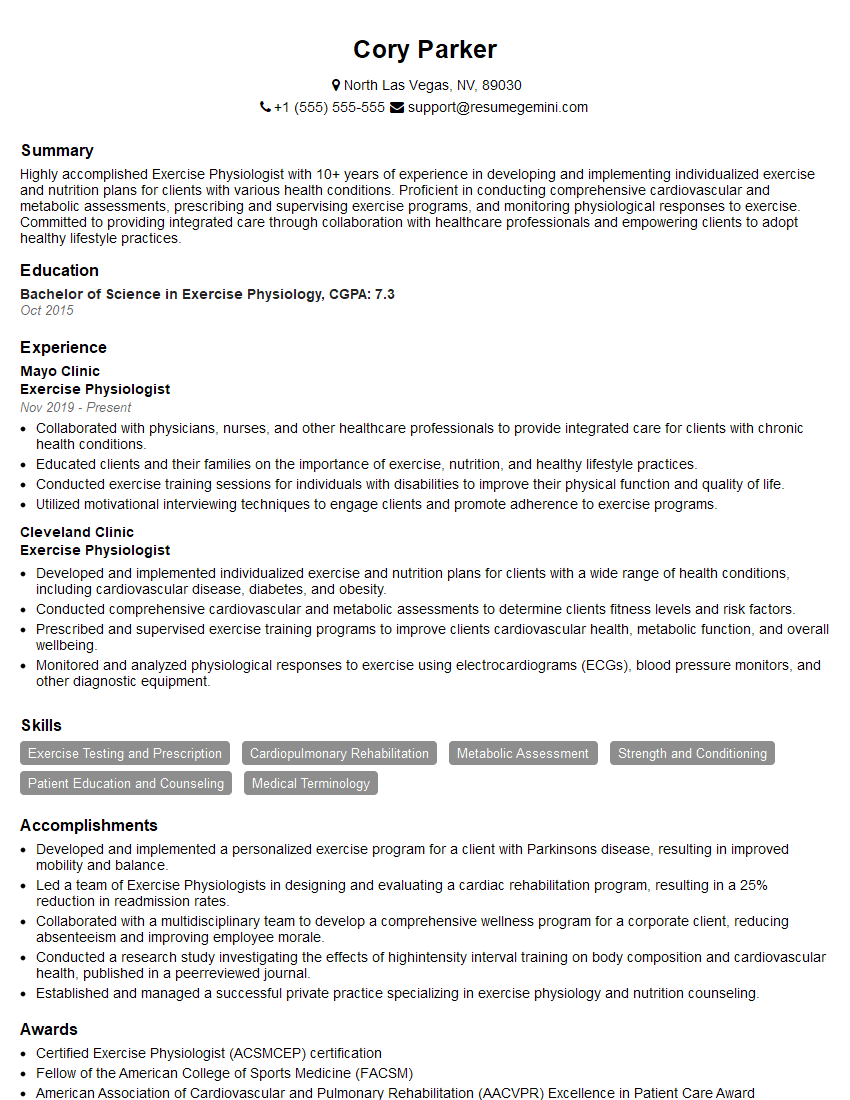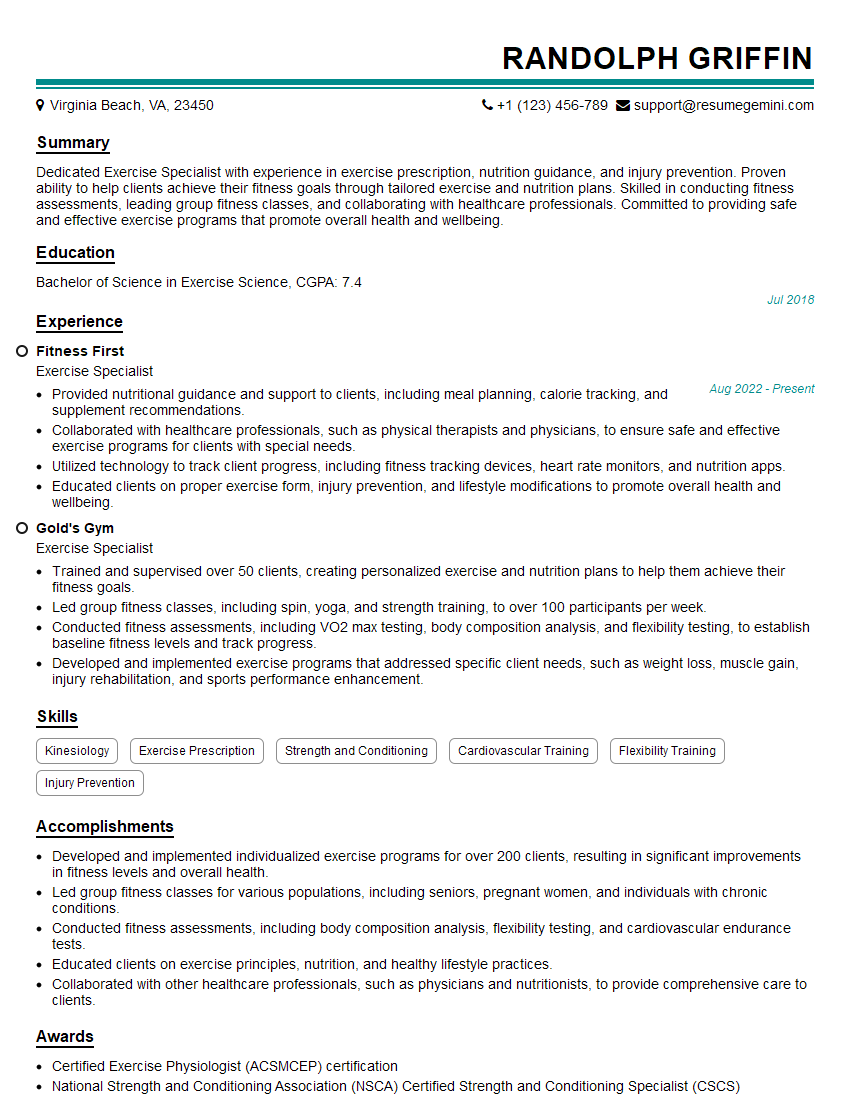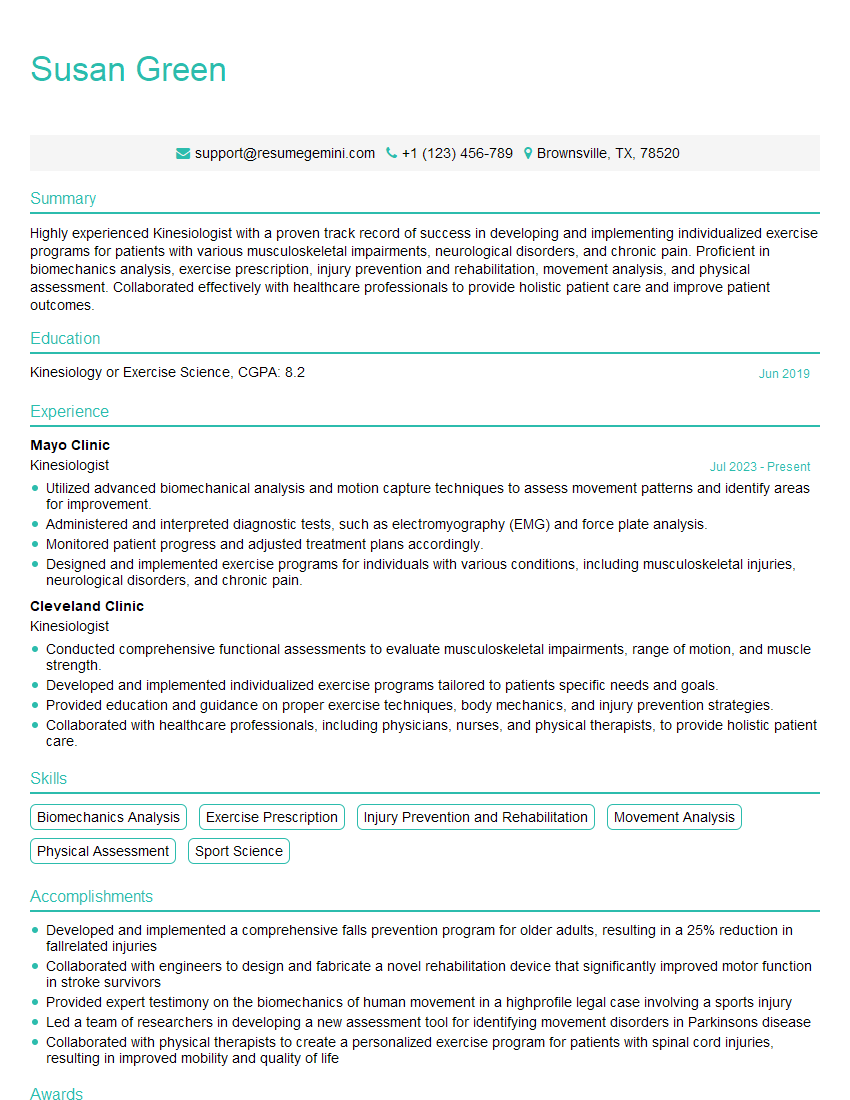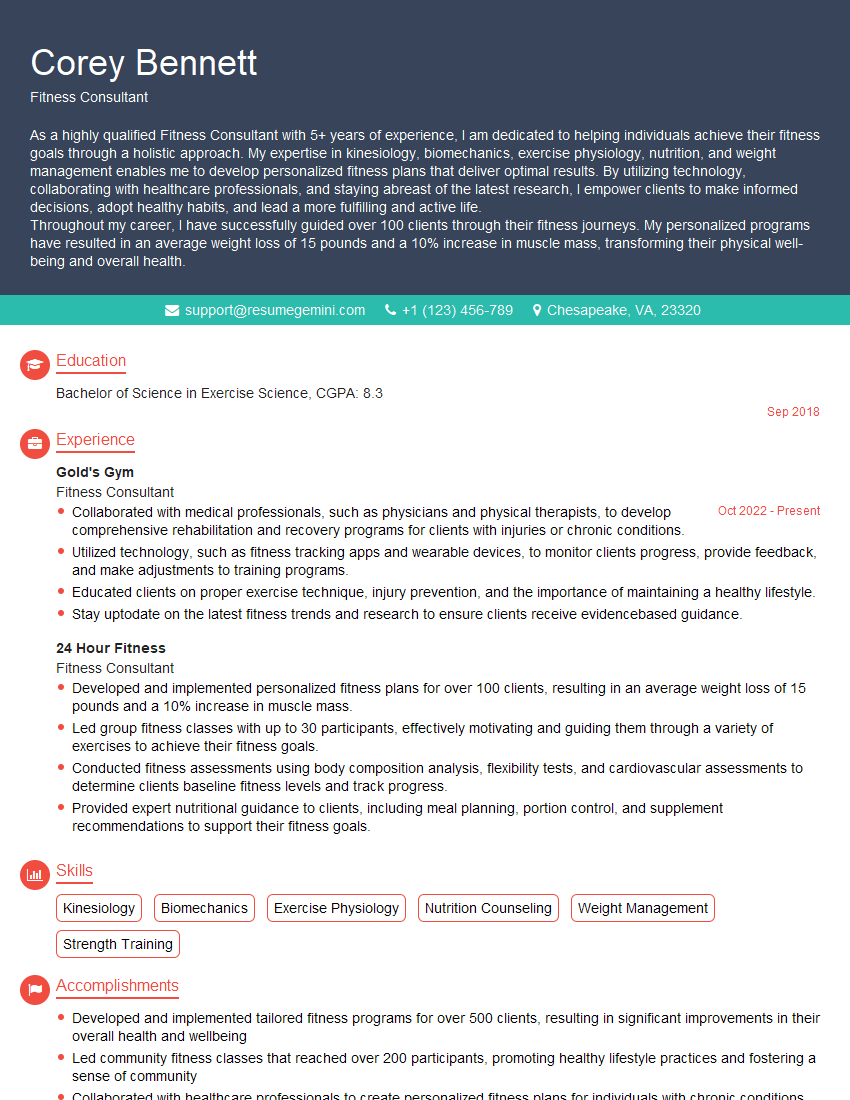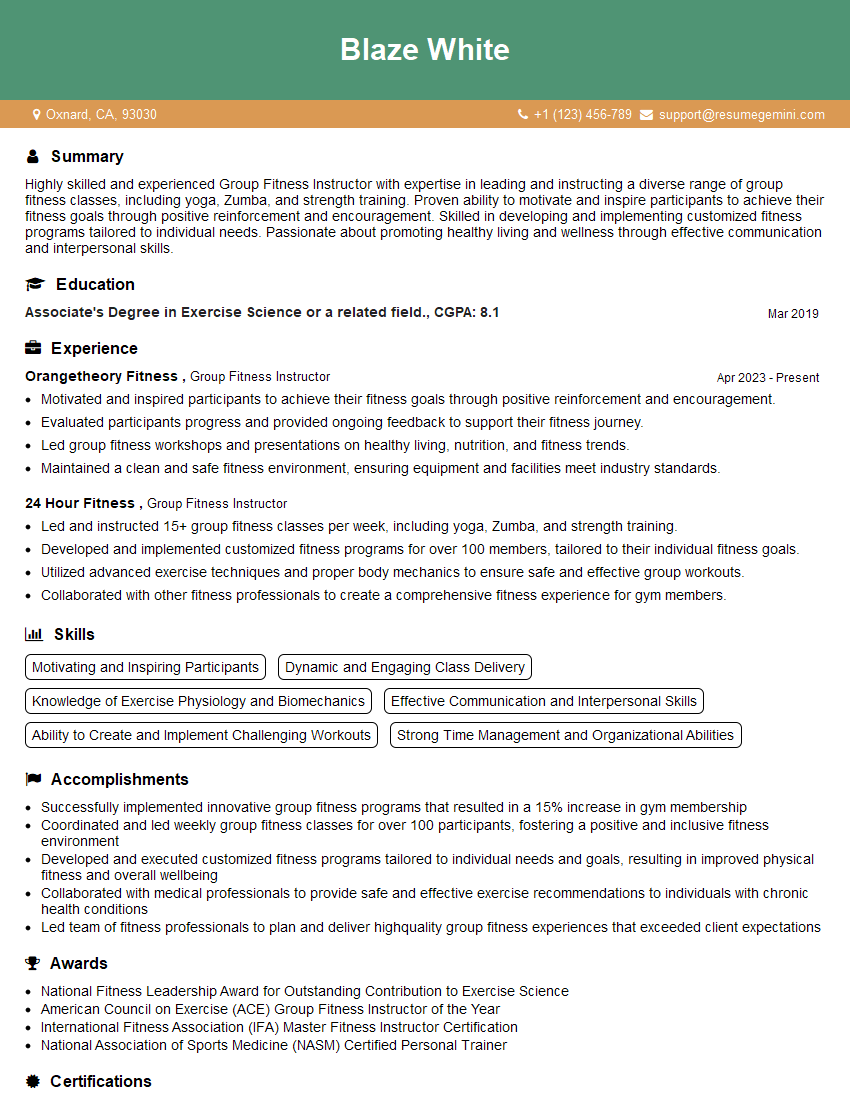Interviews are more than just a Q&A session—they’re a chance to prove your worth. This blog dives into essential Exercise and Fitness Programming interview questions and expert tips to help you align your answers with what hiring managers are looking for. Start preparing to shine!
Questions Asked in Exercise and Fitness Programming Interview
Q 1. Explain the principles of training program design (e.g., specificity, overload, progression).
Designing effective exercise programs hinges on several core principles. Think of them as the foundation upon which you build a successful training plan. Let’s explore three key principles: Specificity, Overload, and Progression.
- Specificity: This principle emphasizes that training should be specific to the desired outcome. If you want to improve your marathon time, your training must focus on endurance running, not just strength training. It’s about matching the training stimulus to the desired adaptation. For example, a basketball player training for improved vertical jump will focus on plyometrics and lower body strength exercises, not long-distance swimming.
- Overload: To see improvement, you must consistently challenge your body beyond its current capabilities. This doesn’t mean pushing yourself to the point of injury, but rather gradually increasing the intensity, duration, or frequency of your workouts. A runner might gradually increase their mileage each week, while a weightlifter might progressively increase the weight they lift.
- Progression: This is the systematic increase in training demands over time. It’s built upon the principle of overload. Progression ensures that you continue challenging your body to elicit adaptations. If you always lift the same weight, your body will eventually plateau. Progression can involve increasing the weight, reps, sets, or the difficulty of the exercises.
These three principles are interconnected and work synergistically. Specificity guides the type of training, overload provides the stimulus for adaptation, and progression ensures continued improvement.
Q 2. Describe different training methods (e.g., circuit training, interval training, plyometrics).
Several effective training methods cater to different fitness goals and preferences. Let’s examine a few popular options:
- Circuit Training: This involves performing a series of exercises one after another with minimal rest in between, creating a circuit. It’s excellent for improving cardiovascular fitness and overall strength. An example circuit might include squats, push-ups, rows, and burpees.
- Interval Training: This method involves alternating between high-intensity bursts of exercise and periods of rest or low-intensity activity. It is highly effective for improving cardiovascular fitness, speed, and power. A common example is high-intensity interval training (HIIT), where you might sprint for 30 seconds and rest for 30 seconds, repeating this cycle for a set duration.
- Plyometrics: This training method focuses on explosive movements that use the stretch-shortening cycle of muscles. It’s ideal for improving power and explosiveness, crucial for sports like basketball or volleyball. Examples include box jumps, jump squats, and depth jumps.
The best method depends on the individual’s goals, fitness level, and preferences. A well-designed program often incorporates elements of different methods.
Q 3. How do you assess a client’s fitness level before designing a program?
Before designing a training program, a thorough fitness assessment is paramount. This helps understand the client’s current capabilities, limitations, and goals. Assessment methods include:
- Health History Questionnaire: This gathers information about existing medical conditions, injuries, and medications. This is crucial to identify any contraindications to specific exercises.
- Movement Screenings: These assess posture, mobility, and fundamental movement patterns to identify any potential muscle imbalances or limitations. Examples include the overhead squat and Thomas test.
- Cardiovascular Fitness Assessment: This measures the client’s aerobic capacity through tests like a graded exercise test (GXT) or a simple submaximal test like a step test or 1.5 mile run.
- Muscular Strength and Endurance Assessment: This involves testing strength through 1-rep max tests or submaximal tests for various muscle groups, and endurance through tests like push-up or sit-up tests.
- Flexibility Assessment: This assesses the range of motion in various joints using tests like sit-and-reach.
- Body Composition Assessment: This determines the proportion of fat mass to lean mass. Methods can include skinfold calipers, bioelectrical impedance analysis (BIA), or underwater weighing.
The combination of these assessments provides a comprehensive picture of the client’s fitness level, enabling the design of a safe and effective program.
Q 4. What are the key components of a comprehensive fitness assessment?
A comprehensive fitness assessment goes beyond just measuring numbers. It’s about building a holistic understanding of the client’s physical capabilities and limitations. Key components include:
- Resting Heart Rate and Blood Pressure: Provides baseline cardiovascular health information.
- Body Composition Analysis: Provides information on body fat percentage, muscle mass, and overall body composition.
- Cardiorespiratory Fitness Tests: Assesses endurance and aerobic capacity. Examples include the VO2 max test or a submaximal test like the Bruce protocol treadmill test.
- Muscular Strength and Endurance Testing: Tests strength and endurance in major muscle groups. This might involve 1-rep max testing for strength and repetition-based testing for endurance.
- Flexibility and Range of Motion Assessments: Assesses joint mobility and flexibility, identifying potential limitations.
- Balance and Coordination Tests: Evaluates postural control and coordination skills, particularly important for older adults or individuals at risk of falls.
- Postural Assessment: Identifies postural deviations that could predispose to injury.
- Movement Screenings: Evaluates fundamental movement patterns to identify muscle imbalances or limitations that could lead to injury.
This multifaceted approach allows for a targeted and personalized training program tailored to the individual’s unique needs and capabilities. Remember to always prioritize safety and obtain informed consent before conducting any assessments.
Q 5. How do you adapt training programs for clients with specific needs or limitations (e.g., injury, age, disease)?
Adapting programs for clients with specific needs is crucial for safety and effectiveness. Modifications depend on the nature of the limitation:
- Injury: Programs must avoid exercises that stress the injured area. For example, a client with a knee injury might substitute squats with leg presses. The program should focus on strengthening supporting muscles and improving range of motion.
- Age: Older adults often have decreased bone density and flexibility. Exercises should be adapted to minimize the risk of falls, emphasizing balance and functional strength training. Lower impact activities should be preferred.
- Disease: Individuals with chronic conditions like heart disease or diabetes require specific modifications. Intensity should be adjusted based on medical advice and the client’s limitations. For example, a client with heart disease may need lower intensity aerobic exercises with careful monitoring of heart rate.
Communication with medical professionals and understanding the client’s limitations are crucial. Modifications may include reducing intensity, frequency, or duration of exercise, choosing low-impact exercises, and incorporating more rest periods.
Progressive overload is still important but needs careful management. For example, increasing the duration of an exercise gradually rather than intensity might be a safer approach in certain conditions.
Q 6. Discuss the importance of periodization in training program design.
Periodization is the strategic manipulation of training variables—volume, intensity, and frequency—over time to optimize performance and prevent overtraining. Imagine it as a carefully planned cycle with distinct phases. A common periodization model is the macrocycle, mesocycle, and microcycle system:
- Macrocycle: The longest phase, usually a year, representing the entire training plan toward a specific goal (e.g., a marathon, a competition).
- Mesocycle: Shorter periods within the macrocycle, typically 4-8 weeks, focusing on specific training goals (e.g., building strength, improving endurance). Each mesocycle might have a specific focus, like hypertrophy in one and strength in another.
- Microcycle: The shortest phase, typically a week, representing the day-to-day training schedule. This phase shows the day-to-day variation in volume and intensity.
By systematically varying these variables, periodization prevents stagnation, minimizes the risk of injury, and maximizes performance gains. It allows for planned periods of rest and recovery, crucial for preventing overtraining and allowing the body to adapt to the training stimulus.
Without periodization, athletes risk plateaus, burnout, and injuries due to constant high-intensity training. A well-structured periodization plan ensures continuous progress toward long-term fitness goals. For example, a strength training program might start with a hypertrophy phase (high volume, moderate intensity), move to a strength phase (low volume, high intensity), and then a power phase (very low volume, explosive movements).
Q 7. Explain the different energy systems and how they influence exercise selection.
The body uses different energy systems to fuel exercise, depending on its intensity and duration. Understanding these systems is vital for exercise selection:
- Phosphagen System (ATP-PCr): This system provides immediate energy for short, high-intensity bursts (e.g., sprints, weightlifting). It’s anaerobic, meaning it doesn’t require oxygen. Exercises targeting this system should be short, explosive movements with ample rest between repetitions.
- Anaerobic Glycolytic System: This system provides energy for moderately intense exercise lasting 30 seconds to 2 minutes (e.g., 400m run). It’s also anaerobic but uses glucose as fuel. Exercises include high-intensity interval training (HIIT).
- Aerobic System (Oxidative System): This system provides energy for prolonged, low-to-moderate intensity exercise (e.g., jogging, cycling). It’s aerobic, meaning it requires oxygen and uses carbohydrates and fats for fuel. Endurance exercises fall under this category.
Exercise selection should consider the energy system primarily used. For example, a training program focusing on sprinting would prioritize exercises that target the phosphagen system, while a marathon training program would concentrate on exercises that use the aerobic system.
It’s important to note that all three systems work together, but one will dominate depending on the intensity and duration of the activity. A well-rounded training program will incorporate exercises targeting all three systems to enhance overall fitness.
Q 8. What are the benefits and risks of different types of cardiovascular exercise?
Cardiovascular exercise, or cardio, significantly improves cardiovascular health and overall fitness. Different types offer unique benefits and risks.
- Benefits of Running: Improves cardiovascular fitness, burns significant calories, strengthens bones (impact), relatively inexpensive.
- Risks of Running: High-impact can lead to joint injuries (knees, ankles), requires proper footwear and surface, potential for overuse injuries.
- Benefits of Cycling: Low-impact, good for joint health, improves cardiovascular fitness, efficient calorie burn.
- Risks of Cycling: Potential for road accidents, requires appropriate safety gear (helmet), can be monotonous for some.
- Benefits of Swimming: Full-body workout, low-impact, excellent for joint rehabilitation, improves cardiovascular fitness, muscular strength and endurance.
- Risks of Swimming: Requires access to a pool, potential for injuries from collisions or improper technique, risk of drowning (even for experienced swimmers).
Choosing the right cardio depends on individual preferences, fitness levels, and health conditions. A balanced approach, incorporating various cardio types, is often most beneficial.
Q 9. How do you design a resistance training program for strength gain versus hypertrophy?
Designing resistance training programs for strength gain versus hypertrophy (muscle growth) requires different approaches, primarily focusing on training volume and intensity.
- Strength Gain: Emphasizes low repetitions (1-5 reps), high weight (85-100% of 1 rep max), and longer rest periods (3-5 minutes). This focuses on maximal neural recruitment.
- Hypertrophy: Emphasizes moderate repetitions (8-12 reps), moderate weight (70-85% of 1 rep max), and shorter rest periods (60-90 seconds). This stimulates muscle protein synthesis.
Example: A strength program for a bench press might involve 3 sets of 3 reps at 90% of the 1RM, while a hypertrophy program might use 3 sets of 10 reps at 75% of the 1RM.
Both programs should incorporate progressive overload – gradually increasing the weight, reps, or sets over time to continue challenging the muscles. Proper form is crucial to avoid injuries in both cases. Consider using a variety of exercises to target different muscle groups effectively.
Q 10. How do you program flexibility and mobility training into a fitness plan?
Flexibility and mobility training are crucial for injury prevention, improved performance, and overall well-being. They should be integrated into a fitness plan systematically.
- Dynamic Stretching: Incorporating movement, such as arm circles or leg swings, should be done before workouts to increase blood flow and prepare muscles for activity.
- Static Stretching: Holding a stretch for 15-30 seconds, should be done after workouts to increase flexibility and range of motion.
- Mobility Work: Focusing on improving the range of motion at specific joints, often involving controlled movements through ranges of motion, this should be done regularly, potentially daily. Examples include foam rolling, self-myofascial release, and specific joint mobilization exercises.
Example: A well-rounded fitness plan might include 5-10 minutes of dynamic stretching before each workout, 5-10 minutes of static stretching after each workout, and 10-15 minutes of mobility work 2-3 times per week.
Consider the individual’s needs and limitations when programming flexibility and mobility work. It is often beneficial to work with a qualified professional, such as a physical therapist or athletic trainer, to address any specific mobility restrictions.
Q 11. Describe the role of nutrition in achieving fitness goals.
Nutrition plays a pivotal role in achieving fitness goals. It provides the fuel for workouts, supports muscle repair and growth, and impacts overall energy levels and recovery.
- Macronutrients: Carbohydrates provide energy, proteins build and repair tissues, and fats support hormone production and overall health. The optimal balance varies depending on individual goals and activity levels.
- Micronutrients: Vitamins and minerals are essential for numerous bodily functions, impacting energy levels, recovery, and immune function.
- Hydration: Water is vital for performance, thermoregulation, and overall bodily functions. Adequate hydration is crucial for both workouts and recovery.
Example: An individual aiming for muscle growth might consume a higher protein intake (1.6-2.2 grams per kilogram of body weight), sufficient carbohydrates for energy, and healthy fats. Someone focusing on weight loss might consume fewer calories overall, prioritizing lean protein and complex carbohydrates.
Individualized nutritional guidance, possibly from a registered dietitian or sports nutritionist, can optimize results and minimize the risk of nutritional deficiencies.
Q 12. How do you motivate clients to adhere to their fitness programs?
Motivating clients to adhere to their fitness programs requires a multifaceted approach that addresses both intrinsic and extrinsic factors.
- Setting Realistic Goals: Collaboratively establishing attainable goals, breaking down large goals into smaller, manageable steps, is key.
- Personalized Programs: Tailoring programs to individual preferences, needs, and limitations, fostering enjoyment and engagement.
- Building a Supportive Environment: Fostering a positive and encouraging relationship with the client, providing regular feedback and celebrating successes.
- Accountability and Tracking: Utilizing various tracking methods, like apps or journals, and providing regular check-ins to monitor progress and maintain motivation.
- Finding Enjoyable Activities: Incorporating activities the client genuinely enjoys, promoting long-term adherence.
Example: Instead of just prescribing a strict exercise plan, collaboratively explore activities the client likes. Celebrating small milestones, adjusting the plan based on client feedback, and regularly reminding the client of their progress can significantly improve adherence.
Q 13. What are the signs and symptoms of overtraining, and how do you address them?
Overtraining occurs when the body is subjected to excessive training without sufficient rest and recovery. Recognizing the signs is crucial for preventing injury and burnout.
- Physical Signs: Persistent fatigue, muscle soreness, decreased performance, increased resting heart rate, sleep disturbances, decreased appetite, and frequent illness.
- Psychological Signs: Irritability, loss of motivation, decreased enthusiasm for training, feelings of anxiety or depression.
Addressing Overtraining:
- Reduce training volume and intensity: Decrease the number of workouts per week, shorten workout duration, and reduce the weight lifted.
- Prioritize rest and recovery: Get adequate sleep (7-9 hours per night), incorporate rest days, and consider active recovery methods (light cardio, stretching).
- Address nutritional deficiencies: Ensure adequate caloric intake, sufficient protein, and proper hydration.
- Manage stress: Implement stress-management techniques such as meditation or yoga.
- Seek professional help: Consult with a physician or certified fitness professional if overtraining persists.
Early intervention is key in preventing long-term consequences.
Q 14. How do you monitor client progress and make adjustments to their programs?
Monitoring client progress and adjusting programs requires a systematic approach.
- Regular Assessments: Conducting periodic assessments, such as strength tests, body composition measurements, and fitness evaluations, to track progress and identify areas for improvement.
- Tracking Metrics: Utilizing apps, journals, or other tools to monitor workout data (e.g., weight lifted, reps, sets, distance run) and subjective feedback (e.g., perceived exertion, sleep quality).
- Client Feedback: Regularly soliciting feedback from clients about their progress, challenges, and preferences to adjust the program as needed.
- Program Adjustments: Based on the assessments and client feedback, making appropriate modifications to the program, including adjusting exercise selection, intensity, volume, or rest periods.
Example: If a client consistently fails to meet their rep goals for a specific exercise, the weight might be reduced, or alternative exercises could be incorporated. If progress plateaus, the program might need to be modified by increasing the intensity or volume, adding new exercises, or altering the training split.
Continuous monitoring and adaptation are vital for maximizing results and ensuring program effectiveness.
Q 15. Explain the importance of proper exercise form and technique.
Proper exercise form and technique are paramount for maximizing results while minimizing the risk of injury. Think of it like building a house – a shaky foundation will lead to collapse, whereas a solid one ensures stability and longevity. Similarly, incorrect form compromises the effectiveness of the exercise and increases the chance of strains, sprains, or more serious problems.
- Muscle activation: Correct form ensures you’re targeting the intended muscle groups. For instance, improper squat form might shift the load to your knees instead of your quads and glutes, increasing knee stress.
- Injury prevention: Maintaining proper alignment protects your joints from excessive stress and wear and tear. A rounded back during a deadlift, for example, puts significant pressure on the spine, increasing risk of injury.
- Performance enhancement: Correct technique allows for greater power, efficiency, and range of motion. A properly executed bench press utilizes your chest, shoulders, and triceps effectively, leading to greater strength gains.
I always emphasize proper form through visual cues, verbal instructions, and sometimes even video analysis. We start with lighter weights or resistance to master the technique before progressing to heavier loads. I also incorporate regular check-ins to ensure the client maintains good form throughout their workouts.
Career Expert Tips:
- Ace those interviews! Prepare effectively by reviewing the Top 50 Most Common Interview Questions on ResumeGemini.
- Navigate your job search with confidence! Explore a wide range of Career Tips on ResumeGemini. Learn about common challenges and recommendations to overcome them.
- Craft the perfect resume! Master the Art of Resume Writing with ResumeGemini’s guide. Showcase your unique qualifications and achievements effectively.
- Don’t miss out on holiday savings! Build your dream resume with ResumeGemini’s ATS optimized templates.
Q 16. How do you handle client injuries or setbacks?
Handling client injuries or setbacks requires a multifaceted approach that prioritizes safety and recovery. My first step is to assess the situation; I would consult with a medical professional if the injury is serious or if I’m unsure of its nature.
- Immediate action: If an injury occurs during a workout, I immediately stop the exercise and assess the severity. This may involve applying first aid (RICE: Rest, Ice, Compression, Elevation) and recommending rest.
- Modified programs: Once the injury is assessed, I modify the exercise program to accommodate the limitations. This could involve substituting exercises, reducing weight, altering the range of motion, or incorporating active recovery strategies.
- Gradual progression: We slowly reintroduce the client to the previous activity level, focusing on proper form and pain-free movement. I frequently use functional exercises to build strength and stability before returning to the original workout routine.
- Communication: Open communication with the client and their medical professional is key. This ensures a collaborative approach to recovery and helps me modify the program according to their progress and needs.
For example, if a client suffers a knee injury, we might temporarily replace squats with elliptical training or swimming until their knee is stronger. We’d then gradually reintroduce squats using lighter weights and controlled movements.
Q 17. What are some common mistakes people make when designing their own workout routines?
Many people make common mistakes when designing their own workout routines, often leading to plateaus, injuries, or lack of progress. Here are some frequent errors:
- Lack of progression: Failing to gradually increase the intensity or volume of workouts. The body adapts quickly, so you need to challenge it constantly.
- Inadequate warm-up/cool-down: Neglecting proper warm-up and cool-down routines can increase the risk of injury and hinder recovery.
- Ignoring rest and recovery: Overtraining without adequate rest leads to burnout and reduced performance. The body needs time to repair and rebuild.
- Poor exercise selection: Choosing exercises that are not appropriate for their fitness level or goals. This might involve attempting advanced moves before mastering the basics.
- Focus on aesthetics over function: Prioritizing looks over proper form and function can lead to inefficient workouts and injury.
- Lack of variation: Sticking to the same routine for too long can lead to plateaus. Variation is key to continued progress.
For example, someone might perform the same 30-minute cardio session daily without increasing intensity or trying different exercises. This lack of variation can lead to a plateau in fitness improvements.
Q 18. How do you create safe and effective workouts that accommodate different fitness levels?
Creating safe and effective workouts for diverse fitness levels involves careful planning and individualization. I always begin with a thorough assessment of the client’s current fitness level, goals, and any limitations.
- Needs analysis: This includes assessing their current strength, endurance, flexibility, and any medical conditions.
- Progressive overload: I implement the principle of progressive overload – gradually increasing the intensity or volume of training over time. This is achieved through modifying reps, sets, weight, rest periods or introducing new exercises.
- Modifications: I tailor exercises to accommodate different abilities. This might include modifying the range of motion, using lighter weights, providing assistance, or suggesting alternative exercises.
- Regressions and progressions: I build in options for both regressions (easier versions of an exercise) and progressions (harder versions) to allow for adjustments based on individual progress.
- Proper warm-up and cool-down: These are crucial for all fitness levels to prepare the body for activity and aid in recovery.
For example, for a beginner, I might start with bodyweight squats and progress to dumbbell squats, while for more advanced clients, I might incorporate weighted barbell squats. For individuals with back pain, I might suggest modifications to squats that minimize spinal stress.
Q 19. Explain your understanding of different training styles (e.g., HIIT, Crossfit, Yoga).
Different training styles cater to various goals and preferences. Understanding their nuances is crucial for effective program design.
- HIIT (High-Intensity Interval Training): This involves short bursts of intense exercise followed by brief recovery periods. It’s excellent for improving cardiovascular fitness and burning calories in a short amount of time. Examples include sprints, burpees, and jump squats.
- CrossFit: A high-intensity fitness program incorporating elements of weightlifting, gymnastics, and metabolic conditioning. It demands a high level of fitness and requires proper coaching to prevent injury. It’s great for building overall strength, endurance, and power.
- Yoga: Focuses on flexibility, balance, strength, and mindfulness. Different styles offer varying levels of intensity. It’s beneficial for stress reduction, improving flexibility, and increasing body awareness.
I choose the appropriate style based on the client’s goals, experience, and physical capabilities. For example, a client focused on weight loss might benefit from HIIT, while someone seeking stress relief and increased flexibility might find Yoga more suitable.
Q 20. How do you incorporate technology or fitness tracking into your programs?
Technology and fitness tracking play a significant role in enhancing program effectiveness and client engagement. I utilize various tools to monitor progress, ensure adherence, and personalize workouts.
- Wearable technology: Fitness trackers and smartwatches provide data on heart rate, steps, sleep, and activity levels, offering valuable insights into client progress and recovery.
- Fitness apps: Apps can be used for exercise tracking, nutrition logging, and providing workout plans. They can enhance client engagement and provide feedback.
- Virtual training platforms: These platforms enable remote coaching and provide a convenient way for clients to track their workouts and communicate with me.
For example, using a wearable device, I can monitor a client’s heart rate during a HIIT session to ensure they’re working within their target zones. I might also use a fitness app to track their progress over time and adjust the program accordingly.
Q 21. How would you design a program for someone new to exercise?
Designing a program for a beginner requires a gradual and safe approach. The focus is on building a foundation of strength, endurance, and proper movement patterns.
- Assessment: The program starts with a comprehensive assessment to identify their fitness level, any limitations, and their goals.
- Fundamental movements: I incorporate basic exercises such as walking, bodyweight squats, push-ups (modified if needed), rows, planks, and lunges. These build foundational strength and mobility.
- Gradual progression: We start with lower intensity and volume, gradually increasing both as the client adapts. This might involve increasing repetitions, sets, or adding light weights.
- Proper form emphasis: I prioritize proper technique over quantity. It’s better to perform fewer repetitions with correct form than many with poor form.
- Consistency over intensity: Regular workouts are more important than intense, infrequent sessions. It’s better to start with shorter, frequent workouts and gradually increase the duration.
- Listen to the body: Rest and recovery are just as important as exercise. I encourage the client to listen to their body and take rest days when needed.
For example, a beginner’s program might start with 30-minute walks three times a week, progressing to include bodyweight exercises two times a week, gradually increasing the duration and intensity over several weeks.
Q 22. How would you adapt a program for someone with cardiovascular disease?
Adapting a fitness program for someone with cardiovascular disease (CVD) requires a highly individualized approach, prioritizing safety and gradual progression. It’s crucial to work closely with the client’s physician to obtain medical clearance and understand any limitations. The program should focus on improving cardiovascular health without overexerting the heart.
Initially, we’d start with low-intensity activities like brisk walking or cycling, gradually increasing duration and intensity as tolerated. We would monitor heart rate closely, ensuring it stays within the target heart rate zone prescribed by the physician. This zone is typically calculated as a percentage of the client’s maximum heart rate, factoring in their age and condition. For example, a client with mild CVD might start with 40-50% of their maximum heart rate and gradually increase to 60-70%.
Strength training should be incorporated, but with a focus on lighter weights and higher repetitions to improve muscular endurance and prevent excessive strain on the cardiovascular system. Exercises should be performed slowly and with proper form to minimize risk of injury. Activities that cause sudden increases in blood pressure or strain the heart, like heavy weightlifting or high-impact aerobics, would be avoided. Regular rest and recovery periods are critical. We will also incorporate flexibility and balance exercises to improve overall function and reduce injury risk.
Throughout the program, consistent monitoring of the client’s vital signs (heart rate, blood pressure) and any symptoms (chest pain, shortness of breath, dizziness) is paramount. Regular check-ins with their physician are essential to ensure the program remains safe and effective. The program’s intensity and duration would be adjusted based on their response and progress.
Q 23. What are some limitations of common fitness tests and how do you account for that?
Common fitness tests, while useful, have limitations. For instance, the VO2 max test, which measures maximal oxygen uptake, can be expensive and require specialized equipment. It also doesn’t always accurately reflect real-world functional fitness. Similarly, the sit-and-reach test, while simple, is only a measure of hamstring and lower back flexibility, neglecting other aspects of flexibility and range of motion.
Another common limitation is the lack of consideration for individual differences. Age, gender, body composition, and underlying health conditions can significantly affect test results. A young, athletic individual will naturally score higher than an older sedentary person, even if both are equally fit for their respective age and condition. Finally, these tests often assess specific isolated movements rather than integrated functional movement patterns.
To account for these limitations, I employ a holistic approach. I combine standardized tests with observational assessments and functional movement screens. For example, I might use a submaximal graded exercise test for cardiovascular fitness instead of a VO2 max test for many clients. This allows for a more practical and safer way to evaluate cardiovascular health without the need for specialized equipment. I’d complement this with functional assessments like observing the client’s form during a squat or lunges to evaluate mobility and stability, allowing for a more comprehensive and personalized evaluation.
I also always conduct a thorough health history interview and consider individual limitations before administering any tests and designing the programs. This includes considering any pre-existing conditions or injuries which will then inform how I adapt and interpret test results. Interpretation is crucial – a below-average score on a test shouldn’t necessarily lead to discouragement, but rather identify areas to focus on improvement.
Q 24. Describe your experience with different types of exercise equipment.
My experience with exercise equipment encompasses a wide range, from basic free weights (dumbbells, barbells) and resistance bands to more advanced machines such as treadmills, ellipticals, stationary bikes, and cable machines. I’m also proficient in using specialized equipment, such as plyometric boxes, medicine balls, and kettlebells. I’m familiar with various weight stack machines found in commercial gyms as well as bodyweight exercises that require no equipment.
I understand the biomechanics of exercise and how to safely and effectively use different types of equipment. This includes proper setup, weight selection, and exercise execution. For example, with free weights, maintaining proper form is critical to prevent injury. With machines, I’m adept at adjusting the settings to accommodate different body types and strength levels. I prioritize safe use of equipment and demonstrate proper form to the client before having them use any piece of equipment, especially new ones.
In my experience, choosing the right equipment is pivotal for tailoring workouts. Resistance bands offer versatility and portability for clients who prefer home workouts, while machines provide more structured and guided exercise for beginners. Free weights allow for enhanced muscle recruitment and a wide range of exercises, while bodyweight training is excellent for building strength and mobility without any equipment. Understanding the strengths and limitations of each type of equipment allows me to choose the optimal tools for each individual client’s needs and goals.
Q 25. Discuss the importance of client communication in the fitness setting.
Client communication is the cornerstone of successful fitness programming. It’s not just about explaining exercises; it’s about building a rapport and understanding the client’s goals, motivations, limitations, and preferences. Effective communication fosters trust and ensures the client feels comfortable and supported throughout their journey. This includes actively listening to their concerns and anxieties.
I begin by conducting a comprehensive initial consultation to understand their fitness history, lifestyle, and health concerns. This conversation helps identify any potential barriers to their success. Throughout the training sessions, I use clear, concise language and avoid jargon. I check for understanding and make adjustments as needed. I encourage open and honest feedback, creating an environment where the client feels comfortable sharing concerns or challenges.
Visual aids, like videos or diagrams, can be particularly useful in explaining proper form or demonstrating exercises. Regular check-ins allow me to monitor progress, address any emerging issues, and adjust the program as needed. I also utilize various forms of communication beyond the actual sessions, like emails, texts, and online platforms for seamless communication and to maintain engagement and accountability. This multi-faceted approach ensures consistent, clear, and effective communication that helps the client achieve their health and fitness goals.
Q 26. How do you handle client concerns or negative feedback?
Handling client concerns or negative feedback requires empathy, active listening, and a problem-solving approach. I always view negative feedback as an opportunity to improve. First, I would thank the client for their feedback and acknowledge their feelings. I would listen attentively and avoid interrupting, ensuring they feel heard and understood.
Next, I’d ask clarifying questions to fully understand the nature of their concern. For example, if they’re unhappy with their progress, I’d ask about their adherence to the program, their nutrition, and any other factors that might be impacting their results. If they feel a specific exercise is causing discomfort, I’d assess their form and adjust the exercise or substitute it with an alternative.
Then, I would collaboratively work with them to develop a solution. This might involve adjusting the program’s intensity, duration, or focus. It could also involve suggesting modifications to exercises or introducing new ones to address the client’s concerns. For instance, if they’re experiencing pain during a certain activity, I might recommend a different exercise or adjust their posture and form. I would track and monitor their progress closely following these adjustments. Open and honest communication is key throughout this process. By working together, we can find the best way to address their concerns and achieve their fitness goals.
Q 27. How do you stay current with the latest trends and research in exercise and fitness?
Staying current in the ever-evolving field of exercise and fitness requires a multifaceted approach. I regularly read peer-reviewed journals like the Journal of Strength and Conditioning Research and Medicine & Science in Sports & Exercise to stay informed about the latest research findings. I also attend industry conferences and workshops, which provide invaluable opportunities to network with other professionals and learn about new techniques and trends.
I actively participate in professional organizations like the American College of Sports Medicine (ACSM) and the National Strength and Conditioning Association (NSCA), accessing their resources and continuing education materials. These organizations offer certifications and updates on best practices. I subscribe to reputable online resources and newsletters that share the latest research and industry news, enabling me to stay abreast of breakthroughs in exercise science and technology.
Moreover, I constantly seek opportunities for self-improvement. This includes reviewing and critically analyzing my own training methodologies, actively seeking feedback from colleagues, and reflecting on my experiences with different clients. This combination of formal education, professional development, and self-reflection ensures I’m equipped with the latest knowledge and best practices to provide effective and safe exercise programming for my clients.
Q 28. How do you ensure the safety of clients during their exercise sessions?
Ensuring client safety is my top priority. This starts with a thorough health history screening to identify any pre-existing conditions or risk factors. Based on this information, I tailor the exercise program to minimize risks and maximize safety. For example, clients with hypertension would have a program different from someone with no medical issues.
Before each session, I explain the exercises thoroughly, demonstrating proper form and ensuring the client understands the movements. I continually observe the client during exercises, correcting any improper form to prevent injuries. I also ensure the workout environment is safe, free of obstacles, and properly equipped. The equipment is regularly inspected to ensure it’s functioning correctly.
I teach clients how to recognize and respond to signs of fatigue or discomfort. I emphasize the importance of proper breathing techniques and warm-up and cool-down routines. I also encourage open communication; clients should feel comfortable voicing any concerns or pain they experience. Emergency procedures are discussed and readily available in the workout area, including readily accessible contact numbers. By implementing these preventative measures, actively supervising, and communicating with clients, I prioritize their safety and well-being.
Key Topics to Learn for Exercise and Fitness Programming Interview
- Needs Analysis & Program Design: Understanding client assessments (e.g., PAR-Q, health history questionnaires), goal setting, and designing individualized exercise programs based on client needs, limitations, and goals. Practical application: Creating a sample program for a client with specific health concerns and fitness levels.
- Exercise Selection & Prescription: Knowledge of various exercise modalities (cardio, strength training, flexibility), understanding exercise biomechanics, and selecting appropriate exercises based on client goals and limitations. Practical application: Justifying the selection of specific exercises within a program, explaining the rationale behind rep ranges and sets.
- Training Principles: A strong grasp of principles like progressive overload, specificity, individualization, and periodization. Practical application: Explaining how these principles are applied in a long-term training program to maximize results and prevent plateaus.
- Program Progression & Adaptation: Understanding how to modify and adjust exercise programs based on client progress, feedback, and adherence. Practical application: Developing strategies to address common challenges like missed workouts or plateauing progress.
- Safety & Risk Management: Identifying potential risks and injuries associated with exercise, and implementing appropriate safety measures. Practical application: Describing how to modify exercises for clients with specific injuries or limitations, ensuring safe and effective training environments.
- Program Evaluation & Feedback: Methods for tracking client progress, evaluating program effectiveness, and providing constructive feedback. Practical application: Discussing different methods to monitor progress (e.g., fitness testing, subjective feedback), and adjusting programs accordingly.
- Communication & Client Interaction: Effective communication techniques for motivating clients, building rapport, and providing clear instructions. Practical application: Developing strategies for addressing client concerns and maintaining motivation throughout the training process.
Next Steps
Mastering Exercise and Fitness Programming is crucial for career advancement in the fitness industry, opening doors to diverse roles and higher earning potential. A well-crafted resume is your key to unlocking these opportunities. To increase your chances of getting noticed by Applicant Tracking Systems (ATS) and recruiters, focus on building an ATS-friendly resume that effectively highlights your skills and experience. ResumeGemini is a trusted resource that can help you create a professional and impactful resume. They provide examples of resumes tailored to Exercise and Fitness Programming to give you a head start. Invest the time to create a compelling resume – it’s an investment in your future success!
Explore more articles
Users Rating of Our Blogs
Share Your Experience
We value your feedback! Please rate our content and share your thoughts (optional).
What Readers Say About Our Blog
Hi, I’m Jay, we have a few potential clients that are interested in your services, thought you might be a good fit. I’d love to talk about the details, when do you have time to talk?
Best,
Jay
Founder | CEO
